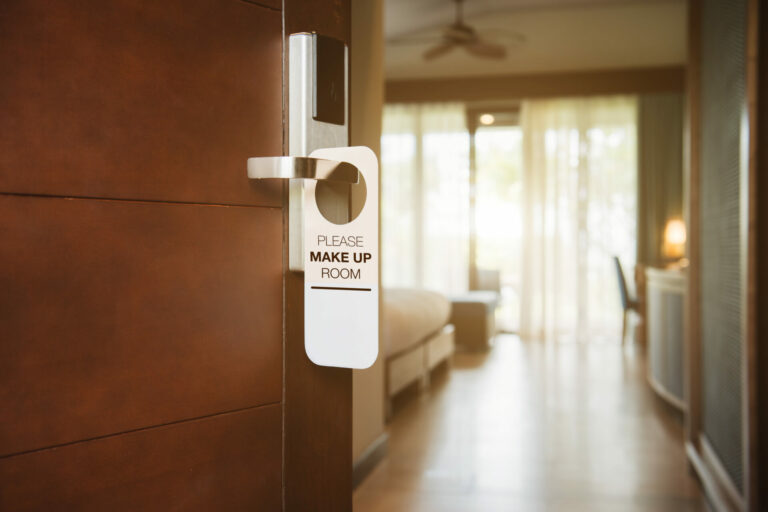Sam-Erik Ruttmann, Director of Global Hospitality Development
In the world of hotel design, the spotlight often falls on luxurious guest rooms or stylish common areas. However, the back-of-house spaces – or the hotel’s support areas – play a crucial role in ensuring smooth operations and exceptional guest experiences.
I remember vividly when I for the first time arrived for work to a hotel I dreamed about working at, as junior staff. I had seen pictures and in fact had a peek inside how the glamorous hotel lobby looked like. I was excited to start my job at this hotel.
I asked the security guard at the hotel gate where the employee entrance was located. The security guard pointed me to a tunnel. The tunnel was leading to among others the employee entrance, receiving area of goods, and garbage collection area. The tunnel was dark, and while I walked towards the receiving area, I could feel the foul stench from the dumpster. What I just described was a common approach and still is a common way to design a hotel back of the house, combining multiple functions for the space efficiency. While I am all for considering efficiency and flow, it is also important to consider the employees arrival experience to their work place. After all they will be expected to create magic and unforgettable moments for the hotel guests.
Uncommon expert advice
Here are some uncommon expert tips to help you create efficient, functional, and employee-friendly back-of-house spaces in your hotel project, when to bring the consultants on board the project.
Hotel includes more consultants than most building types because of the variety of special operational and technical requirements, such as kitchen, laundry, and all the audio visual requirements to name a few, that are part of most resorts.
Among the first contracts the owner signs, before architect or interior designer or construction agreement, is the technical services agreement with the future hotel operator. The technical service agreement covers input throughout the planning and construction phases the Owners project team.
The reason it is important:
Prioritize Space Efficiency and Flow
Design back-of-house areas to have a seamless flow between different functions. This not only improves efficiency but also reduces the risk of cross-contamination between departments.
Receiving, Trash and General Storage Areas
The hotel’s receiving area and trash areas, while sharing the loading dock, require clear separation of incoming and outgoing goods.
Possibly in smaller hotels the functions are actually combined into a single area. The receiving area connects directly to the main back-of-house corridor and eventually, to each major service area. In some hotels the receiving area is immediately adjacent to the kitchen. This is an advantage to the Food & Beverage department but may necessitate an unusually long route to move goods to the other departments, such as housekeeping, laundry, maintenance or general store area.
Equally important to the layout of the receiving and trash areas is its integration with the site plan so that it accommodates the necessary movements of trucks without disrupting the guest parking, yet it is hidden from the hotel guest rooms, and public areas such as restaurants etc.
More often the trucks that are collecting garbage, empty bottles are coming to the hotel in early morning hours, and believe me it is noisy.The delivery of goods happens also in the early morning hours.
An otherwise well designed hotel can be severely downgraded by the poor location of its receiving and trash areas.
Hotels require considerable amounts of storage area. Most of its space is associated with specific activities: food storage near the kitchen, linen storage on each floor to name a few.

Kitchen

Housekeeping
The housekeeping and if there is a laundry create another important element of service facilities of a major hotel. In large hotels the amount of space required for linen storage is substantial. If there is a large laundry service available near the hotel, the developer will not invest in building its own laundry. However in a destination hotel where distances are far to commercial laundries the inhouse laundry is the solution.
If there is an inhouse laundry, the housekeeping areas should be adjacent, even though they are managed separately. But if the laundry space is omitted, extensive areas are still required for collecting and loading soiled laundry and receiving and storing clean linen. The main functions of course are to clean and distribute guestroom ( bed and bath) linen, restaurant linen, uniforms, kitchen linens, and pool towels.
In hotels with several floors there are some good alternatives to transporting dirty linen in trolleys to the laundry or dirty linen storage areas. A clever solution is to incorporate a linen chute that connects to every floor in the service elevator landing.

I am allergic to counters that separate the guest from the staff, and staff has a large computer display which is the focus of their work.
I realize that front desks have been around for the longest time, however with the technology on hand, I argue that the guest experience improves when the guest and staff meet on ¨the same side of a counter¨. I have seen solutions such as round satellite stations located where the check in and check out experience is more pleasant. In some hotels I have seen that guests are invited to take a seat and the guest experience officer will check the guest in and out utilizing the hand held device.
The back office functionalities remain with any necessary paperwork, out of guest view.
Here are ten common mistakes that back-of-house consultants may make when designing back-of-house spaces:
Invest in Employee Comfort and Well-being
A comfortable and well-designed workspace contributes to employee satisfaction and productivity. Provide a great view to the nature, ample natural light, ergonomic furniture, and dedicated break areas for your team members. Don’t forget to include spaces for training and ongoing education to support staff growth and development.
Incorporate Sustainable Practices
Green initiatives shouldn’t be limited to the front-of-house. Implement energy-efficient equipment, waste reduction strategies, and eco-friendly cleaning products in your back-of-house areas. This not only helps the environment but also contributes to cost savings in the long run.
Plan for Future Expansion and Adaptability
As your hotel grows, so will your back-of-house needs. Plan ahead by designing these spaces to be flexible and adaptable to accommodate changes in staff numbers, technology, and operational requirements.
Ensure Seamless Connectivity and Integration
In the age of technology, the back-of-house team relies on various software and systems for efficient operations. Design these spaces with connectivity in mind, ensuring that your staff has access to the latest technology and that systems are seamlessly integrated.
Focus on Safety and Security
A safe and secure work environment is vital for your staff’s well-being. Incorporate security measures such as surveillance cameras, access control systems, and proper lighting. In addition, allocate space for safety equipment and training resources to ensure that your team is well-prepared for emergencies.
Involve Your Team in the Design Process
By prioritizing these expert tips in your hotel project, you’ll create a back-of-house area that supports your team and contributes to the overall success of your property. Remember, a well-designed back-of-house space is the backbone of any thriving hospitality business.
Hospitality Tomorrow is a blog series by Sam-Erik Ruttmann our Director of Global Hospitality Development.
Studio Puisto
Mariankatu 7 A 4
00170 Helsinki
[email protected]